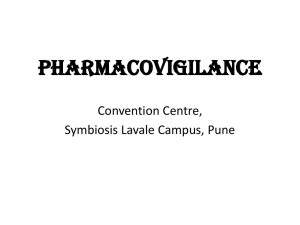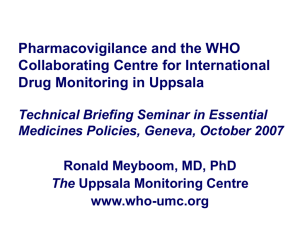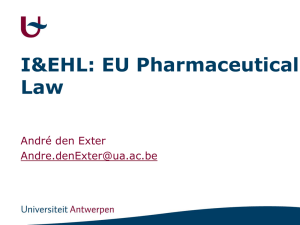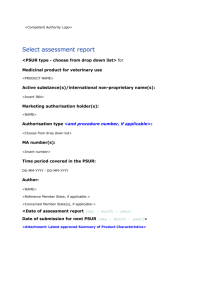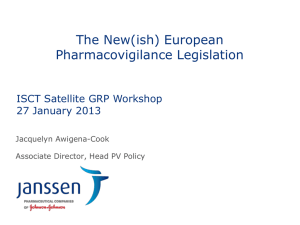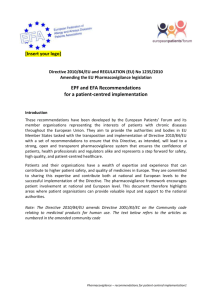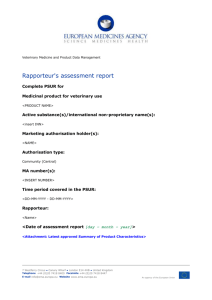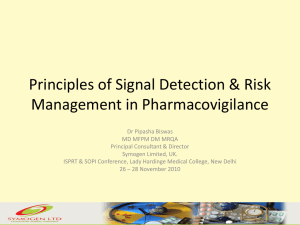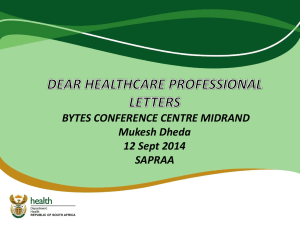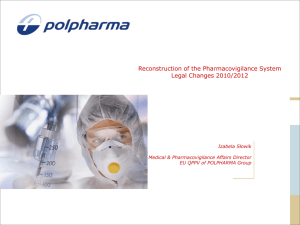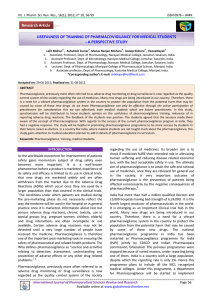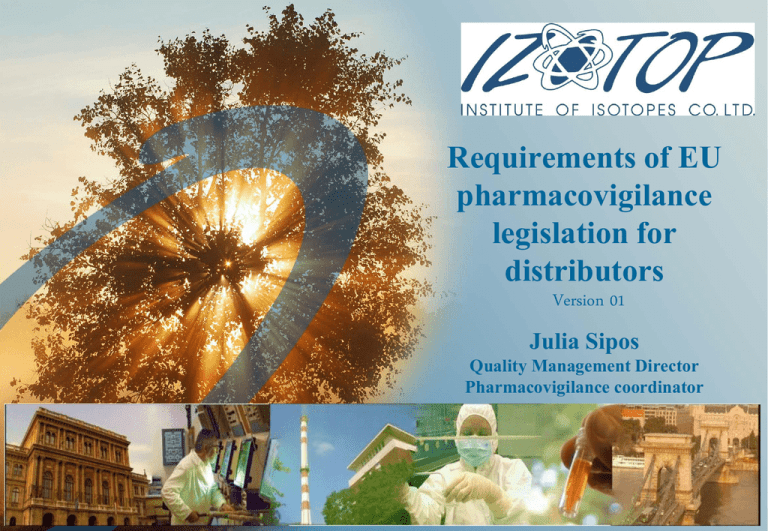
Requirements of EU
pharmacovigilance
legislation for
distributors
Version 01
Julia Sipos
Quality Management Director
Pharmacovigilance coordinator
Pharmacovigilance
Science and activities relating to the detection,
assessment, understanding and prevention of
adverse effects or any other medicine-related
problem
(Guideline on good pharmacovigilance practices –GVP - Annex I –
Definitions)
Version 01
2
Objectives
Today’s work supports tomorrow’s safety
Pharmacovigilance activities provide
–
–
–
–
Version 01
more information on the pharmaceuticals as
• during clinical investigations limited information can be gained
• some impacts may become known in long term only
• real environment of use may be different from that of the
clinical investigation
free flow of and access to information on pharmaceutical safety
room for necessary measures to be taken by MAH
useful information to required risk assessment
3
Tools and scope
Tools to achieve the objectives
–
–
continuous collection all available information (signals)
share the information gained: report adverse events to the EU
database (according to law)
Scope
–
Version 01
Distributed pharmaceuticals where Institute of Isotopes is the
MAH
(however other MAHs can have similar requirements)
4
Definitions
Signal
Science and activities relating to the detection, assessment,
understanding and prevention of adverse effects or any other
medicine-related problem
Adverse event (AE)
Any untoward medical occurrence in a patient or clinical trial subject
administered a medicinal product and which does not necessarily
have a causal relationship with this treatment
Version 01
5
Definitions
Adverse (drug) reaction (ADR)
A response to a medicinal product which is noxious and unintended
Response in this context means that a causal relationship between a
medicinal product and an adverse event is at least a reasonable
possibility
Adverse reactions may arise from use of the product within or outside
the terms of the marketing authorisation or from occupational
exposure. Conditions of use outside the marketing authorisation
include off-label use, overdose, misuse, abuse and medication errors.
Version 01
6
Definitions
Serious adverse event (SAE)
An adverse reaction which results in death, is life-threatening,
requires in-patient hospitalisation or prolongation of existing
hospitalisation, results in persistent or significant disability or
incapacity, or is a congenital anomaly/birth defect.
Life-threatening in this context refers to a reaction in which the
patient was at risk of death at the time of the reaction; it does not
refer to a reaction that hypothetically might have caused death if
more severe.
Version 01
7
Abbreviations
MAH: Marketing Authorization Holder – in this case:
Institute of Isotopes
QPPV: Qualified person for pharmacovigilance
SDEA: Safety Data Exchange Agreement
CIOMS (form): Council for International Organizations of
Medical Sciences - form for Suspect adverse event report
Version 01
8
Types of adverse events
Diagram shows the relationships of adverse events, serious
adverse events that can be unexpected and drug related
Yellow part shows cases to be reported to the EU database
Version 01
9
The legal framework of pharmacovigilance for
medicines marketed within the EU/1.
Basic
–
–
Version 01
Regulation (EC) No 726/2004 with respect to centrally authorised
medicinal products
(laying down own Community procedures for the authorisation
and supervision of medicinal products for human and veterinary
use and establishing a European Medicines Agency)
Directive 2001/83/EC with respect to nationally authorised
medicinal products (including those authorised through the mutual
recognition and decentralised systems)
(on the Community code relating to medicinal products for human
use)
10
The legal framework of pharmacovigilance for
medicines marketed within the EU/2.
Additional
–
–
Version 01
Commission Implementing Regulation (EU) No
520/2012 includes details in relation to certain aspects of
pharmacovigilance to be respected by marketing authorisation
holders, national competent authorities and EMA
(on the performance of pharmacovigilance activities provided for
in Regulation (EC) No 726/2004 of the European Parliament and
of the Council and Directive 2001/83/EC of the European
Parliament and of the Council)
Good pharmacovigilance practice guidelines(GVP) released by
EMA in order to facilitate the performance of pharmacovigilance
activities. (These GVP modules replace Volume 9A)
11
Requirements for distributors/1.
To be familiar with relevant requirements of EU legislation
on pharmacovigilance
To be familiar with their national legislation on
pharmacovigilance
Share with MAHs the following information as a
minimum:
–
national requirements for pharmacovigilance
– access data of person responsible for receiving all incoming
information on drug safety (adverse reactions): name, e-mail,
phone number, address.
Any changes in these data shall be reported immediately to the
MAH’s QPPV.
Version 01
12
Requirements for distributors/2
Conclude a SDEA with the MAHs – covering in detail all
co-operation
–
activities
– tasks and
– responsibilities
of the parties in terms of pharmacovigilance
Continuous screening of domestic professional literature for
any safety issues of the distributed pharmaceuticals – report
any signals to MAHs
Version 01
13
Requirements for distributors/3
Encourage their partners (health institutions and/or health
care professionals and/or patients as applicable) to report all
information on drug safety
For this purpose:
–
–
–
–
Version 01
share contact data with their partners
provide information on the 4 necessary (minimum) data to
MAH – see next slide
forward all information arriving from the MAH to their
partners in this issue in due time
inform their partners on further fate of their reported signals or
adverse/pregnancy events
14
Requirements for distributors/4
Information may arrive from
–
–
patients/their relatives or
healthcare professionals)
Collect and provide all follow-up information if required by
MAH
–
–
additional data related to the reported case
answer on authorities’ requests
Meet time frames required by MAH for
Pharmacovigilance information must not be made public
Version 01
15
Reporting to MAH
Report
–
–
–
signals, adverse or pregnancy event information to the MAH’s
QPPV
immediately
via e-mail or fax using free text or phone or using CIOMS form
(Can be downloaded from: http://www.cioms.ch/)
At least four basic data shall be included
–
data of the reporter (name, address, access data, e.g. e-mail
address or phone number)
– patient data (monogram or identification code, date of birth or
age, sex)
– at least one suspected pharmaceutical
– at least one suspected adverse event
Version 01
16
Special cases
Institute of Isotopes (IoI) is distributor of a product of another
MAH
In case of incoming event report
–
–
–
Version 01
the same information should be sent to that MAH as in case of
IoI’s product and
please send to IoI as well for information
if no contact is available to the MAH, send the information to IoI
17
Contacts at IoI
Pharmacovigilance Coordinator (connection to QPPV)
Sipos, Julia
e-mail: gyogyszerbiztonsag@izotop.hu
phone: +36-1- 391-0900
mobile: +36-30-991-0468 (available 24 hours/day)
Version 01
18
Contact us in case of any questions!
THANK YOU FOR YOUR ATTENTION!
Version 01
19

